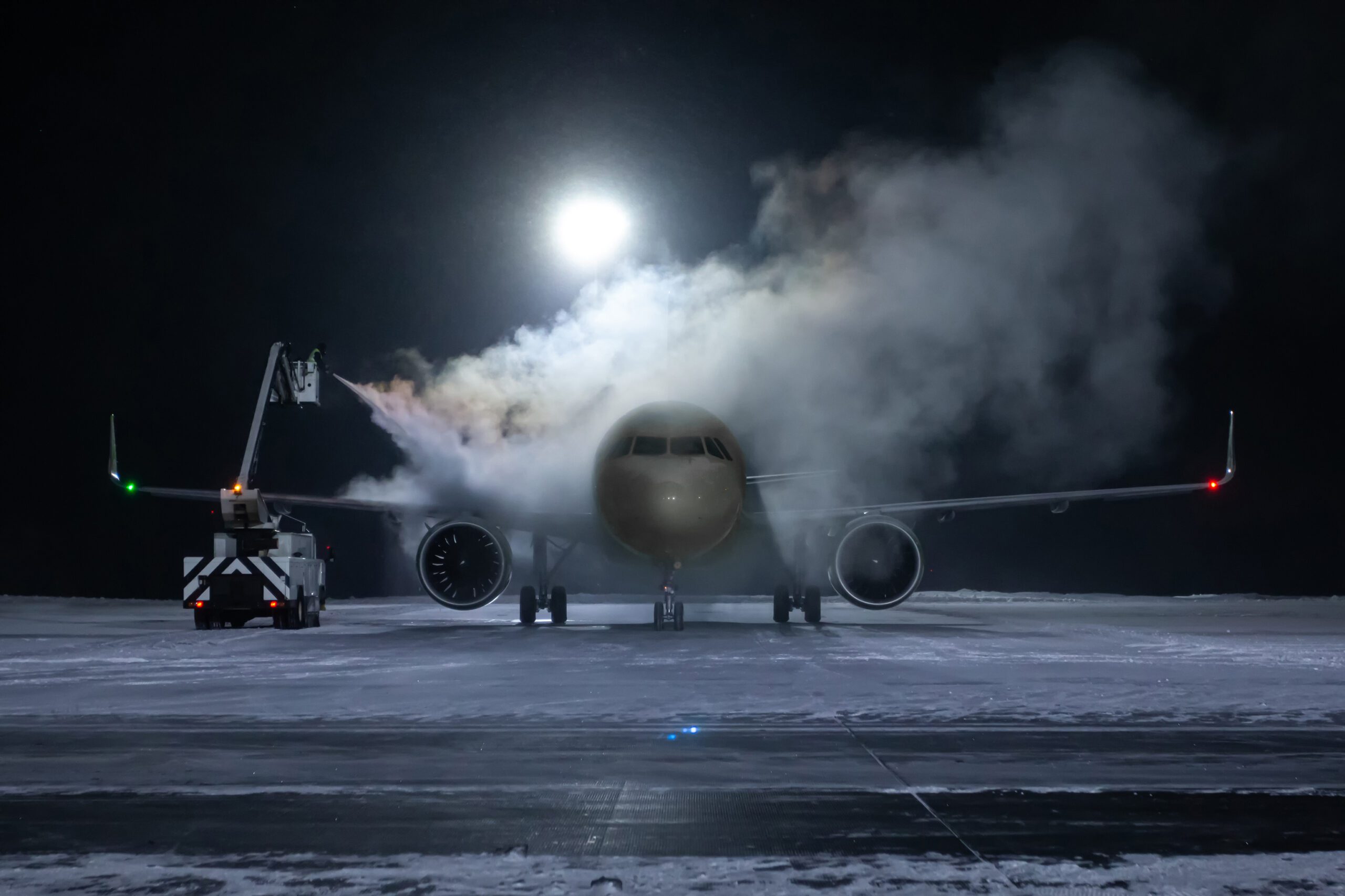Weather intelligence for the future: Crafting a strategic enterprise approach to changing environmental conditions
Continue readingKey takeaways
- Accurate forecasting helps airlines anticipate airplane icing conditions and visibility limiting fog before they disrupt operations.
- Data-driven weather intelligence supports safer, more efficient flight planning across global airline networks.
- Advanced forecasting APIs deliver real-time updates that enhance operational readiness and minimize costly delays.
- Integrated weather solutions enable flight operations teams to maintain safety, schedule reliability, and cost efficiency in all conditions.
Every minute in aviation counts, and weather owns many of them. Small atmospheric changes can drive major operational costs. This includes airplane icing conditions that ground morning departures and dense fog that leads to diversions. These events can also disrupt flight schedules, increase fuel burn, and impact passenger safety.
As the world’s most accurate forecaster,1 The Weather Company helps airlines stay ahead. Tools like GRAFTM and outlook reports from Weather Forecast Services empower airlines to anticipate these evolving risks with the clarity and speed needed to plan with confidence rather than react under pressure.
Understanding the risks
Ice
Airplane icing conditions are a persistent threat to both flight performance and safety. While hazardous icing is less common for large commercial jets, even modest ice buildup can impact efficiency and safety. If not anticipated, ice accumulations can rapidly destabilize flight performance. NASA studies show this is because ice reduces lift by 30% and increases drag by 40%.2 As recently as 2024, ice formation was reported as a significant contributing factor in a crash resulting in 62 fatalities.3
On the ground, frost and freezing precipitation complicate ramp and deicing operations. Well-designed deicing facilities are central to safe winter operations. They integrate dedicated deicing pads, glycol collection systems, and fluid recovery infrastructure to streamline aircraft movement.4 These purpose-built areas allow multiple aircraft to be treated simultaneously while minimizing environmental impact and congestion near runways. As a result, airports and airlines that invest in modern deicing infrastructure enhance both safety and operational throughput when winter weather conditions intensify.
Fog
Fog is one of the most common and costly weather hazards in aviation, costing the aviation industry billions annually. A 2025 global review of fog and aviation research found that fog remains a leading cause of wintertime flight delays, prompting airports to invest in advanced forecasting and landing systems.5
Low visibility reduces runway throughput, slows taxi operations, and disrupts arrival sequencing during peak traffic periods. Recent machine learning studies have demonstrated significant gains in fog prediction accuracy, improving the ability to anticipate onset and dissipation times.6 With higher-resolution modeling and AI-driven forecasts, operational teams can adjust routing, scheduling, and ground coordination before visibility drops.
Proactive forecasting for safer, smarter decisions
The Weather Company equips aviation professionals with forecasting tools that go beyond traditional radar and model output. Each product translates complex data into actionable insights for flight operations and delivers decision-ready intelligence. This is achieved by combining high-resolution modeling with continuous aviation weather monitoring.
Visibility and fog forecasting tools
- WxMix™ (Weather Model Mixer): Analyzes more than 100 global weather models to pinpoint visibility drops before they impact operations.
- Human-Over-the-Loop™ (HOTL) intelligence: Refines AI-driven forecasts with expert meteorologist oversight for more accurate fog formation and dissipation timing.
- Forecasts On Demand™ (FOD) engine: Delivers real-time visibility updates by integrating multiple forecast sources for continuous operational awareness.

Icing forecasting tools
- Frost probability forecast: Indicates the likelihood of frost formation with risk tiers to guide pre-dawn de-icing and ramp operations.
- 3-day and 5-day international risk outlooks: Extends insight into regional icing trends, supporting global network operations and asset planning.
Together, these tools create an integrated operational forecasting ecosystem that supports continuous situational awareness for both convective and icing events. The Weather Company’s aviation icing forecast solutions give flight operations teams early insight into where and when frost, freezing rain, or ice buildup may affect aircraft performance and ground operations.
Data power: APIs that deliver accuracy and speed
Behind each Weather Company aviation product is a data infrastructure engineered for speed and security. Our optimized weather APIs allow organizations to access real-time decision support data at scale. We offer a comprehensive API portfolio designed to deliver the industry’s fastest, most reliable weather intelligence. This includes over 180 unique weather products and 4,000 endpoints, covering aviation, seasonal forecasts, lightning data, and more.
In aviation, where timing is critical, this difference matters. The Weather Company APIs deliver up-to-the-minute weather insights that enhance operational timing and reduce the cost of weather-related disruptions – helping airlines move from reactive to proactive management.
Purpose-built APIs for smarter aviation operations
Tiler Packed API technology reimagines raw gridded data delivery – reducing API call requests by up to 200 times for the same datasets. Packaging related layers – such as 50 flight levels of aviation weather data – into a single request improves data-transfer efficiency. This enables advanced visualizations like 3D icing potential or turbulence renderings.
Similarly, the Multi-Point API retrieves forecast conditions along a 3D flight path. It processes GeoJSON-compatible routes or waypoint sets and inspects all underlying gridded data, returning actual values in text format. Additionally, it offers optional downsampling to increase data frequency along the route.
This on-demand architecture helps dispatch systems, EFBs, flight-following tools, and other operational platforms receive continuously updated forecasts without redundant data calls. By aligning API requests with actual operational activity, such as flight plan updates or icing alerts, airlines minimize latency, reduce system load, and maintain situational precision.
Global scale and reliability
The scale behind this performance is equally impressive. The Weather Company platform ingests more than 500 terabytes of weather information every day and handles an average of two million requests per second, totaling 200 billion per day and six trillion per month. A 100% cloud-based, globally redundant infrastructure allows for greater resilience and continuous availability.
of weather information ingested each day
requests per second
Real-world impact: From forecast to flightline
Research consistently shows that weather is among the largest contributors to flight delays and operational costs. Flight delays and cancellations cost the U.S. economy roughly $30 billion to $34 billion in 2022 alone.7 This reflects lost productivity, additional airline expenses, and broader economic ripple effects. By integrating The Weather Company’s tools and APIs, airlines can mitigate many of these losses through early detection, adaptive routing, and coordinated response.
In practical terms, these forecasting innovations allow flight operations teams to:
- Identify high-risk airplane icing conditions before they form.
- Anticipate fog formation that could delay or reroute flights.
- Optimize de-icing resource allocation to minimize idle time.
- Improve coordination between dispatch, ATC, and ground crews.
The result is not only enhanced safety but measurable operational efficiency – where fewer delays, reduced fuel consumption, and smarter asset utilization directly impact the bottom line.
Operate confidently in any condition
The Weather Company’s aviation solutions unite scientific rigor, high-performance data infrastructure, and proven accuracy to help operations teams prepare for every scenario. From predicting airplane icing conditions to analyzing fog outlooks, these tools empower airlines to stay ahead of weather, not behind it.
Talk to a Weather Company expert to learn how integrating these forecasting and API-driven insights can strengthen your operational readiness and help your airline operate confidently – no matter what the atmosphere delivers.
Let's talk
To learn more about our advanced aviation weather solutions, contact our aviation experts today.
Contact us1 ForecastWatch, Global and Regional Weather Forecast Accuracy Overview, 2021-2024, commissioned by The Weather Company.
2 National Aeronautics and Space Administration (NASA), Aircraft Icing Research at NASA Glenn Research Center, 2013.
3 NPR, Cockpit audio indicates issues with de-icing in deadly Brazil plane crash, 2024.
4 Federal Aviation Administration, Advisory Circular 150/5300-14D: Design of Aircraft Deicing Facilities, 2020.
5 Springer Nature, Fog and Global Aviation: The State of Knowledge Evolution, 2025.
6 Atmospheric Research, Efficient prediction of fog-related low-visibility events with Machine Learning and evolutionary algorithms, 2023.
7 U.S. Department of Transportation and AirHelp, Cost of Disrupted Flights to the Economy, 2024.







